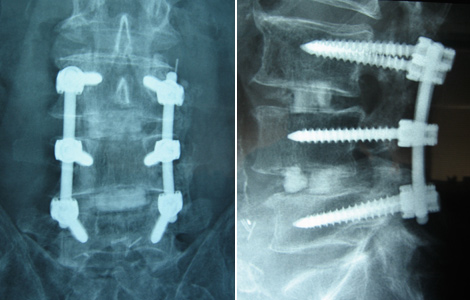Interventional Orthopedics and Interventional Pain Medicine Physician
What is a Lumbar Fusion?
Lumbar fusion is a corrective spinal surgery intended to decrease excess motion of the lumbar spine that is though to be contributing to pain or loss of function. Fusing the spine may help stabilize the specific vertebrae involved, but often leads to more surgeries as time goes on. When portions of the lumbar spine are fused, the lumbar disks above and below the fusion often degenerate at an increased rate. Unfortunately, a common treatment for this is extending the fusion, perpetuating the surgical cycle.
Alternatives to lumbar fusion
Responsible physicians know that it is best to avoid fusion surgery if possible. Injection therapy is often utilized first as an alternative. Epidural steroid injections and radiofrequency ablation are common techniques that can relieve symptoms. However, these are not intended to cure but to decrease symptoms only. Surgeries that attempt to address the “root cause” of the problem that don’t involve implanting hardware include microdiscectomies, laminectomies, and foraminotomies. These surgical techniques can help relieve symptoms as well but often time don’t address the underlying cause, which is typically instability putting excess pressure on a disk that then herniates and compresses a nerve. As more and more tissue is altered, the overall structure is compromised. Performing these less invasive surgeries at more than one level can result in significant instability leading to potential loss of function if not addressed with (you guessed it), another fusion.
My Patient’s Story
Several months ago, I evaluated a new patient regarding her recurrent low back pain that occasionally radiated to her legs. Years ago, she had undergone a microdiscectomy that had resolved her issues at the time. Recently, however, she had been injured while skiing and had not been able to recover. She had already gone through treatments listed above, such as epidural steroid injections and radiofrequency ablation with no significant relief. She was contemplating another surgery by the time she came to see me. Her pain even caused her to go on short-term disability because she was not able to perform her normal duties at work.
A Promising Alternative Treatment
Platelet lysate is a concentrated solution derived from platelets, cells that circulate throughout our body that play a large roll in our inherent healing mechanisms. Platelets contain several growth factors that stimulate the healing process. We obtain platelet lysate by performing a simple blood draw and then processing that blood and concentrating the growth factors to be re-injected into the areas of the low back that need attention. These areas include the epidural space where spinal nerves reside, facet joints that play a role in rotation and extension, as well as the ligaments and muscles that provide overall stability to the lumbar spine. Experience tells us that chronic lumbar spine issues typically require multiple treatments over time. We performed a second injection recently, as she was currently reporting 50-60% relief at 3 months after the first injection and we were both hoping for more. She is happy to be back at work and back to long walks and hiking as well.
One Piece of the Puzzle
Not everyone needs injections to treat low back pain. For those who are considering injections or have already received them, please don’t forget about other effective treatments:
- Physical therapy: Improving core strength, flexibility, and increasing blood flow are critical to making a complete recovery.
- Diet: Focusing on anti-inflammatory foods and reducing processed food intake can help you lose excess body fat and put less pressure on your lumbar disks.
- Tincture of time: Rest can give your body time to heal. Pushing through pain is not recommended when it comes to the lumbar spine.
Take Home Message
Platelet lysate has promising treatment potential for issues related to the lumbar spine. Epidural steroids, radiofrequency ablation, surgery, are all possible means to avoid a lumbar fusion. However, these options that do not include your own healing cells carry associated risks and often do not treat the underling issue. If you suffer from a condition similar to this, I highly encourage you to seek out a physician who is trained in these cutting edge techniques to achieve the best result possible and to avoid the perpetual surgical cycle.
